The ASRock X99E-ITX/ac Review: Up to 36 Threads in Mini-ITX
by Ian Cutress on June 24, 2015 8:00 AM ESTSystem Performance
Power Consumption
Power consumption was tested on the system while in a single MSI GTX 770 Lightning GPU configuration with a wall meter connected to the OCZ 1250W power supply. This power supply is Gold rated, and as I am in the UK on a 230-240 V supply, leads to ~75% efficiency > 50W, and 90%+ efficiency at 250W, suitable for both idle and multi-GPU loading. This method of power reading allows us to compare the power management of the UEFI and the board to supply components with power under load, and includes typical PSU losses due to efficiency. These are the real world values that consumers may expect from a typical system (minus the monitor) using this motherboard.
While this method for power measurement may not be ideal, and you feel these numbers are not representative due to the high wattage power supply being used (we use the same PSU to remain consistent over a series of reviews, and the fact that some boards on our test bed get tested with three or four high powered GPUs), the important point to take away is the relationship between the numbers. These boards are all under the same conditions, and thus the differences between them should be easy to spot.
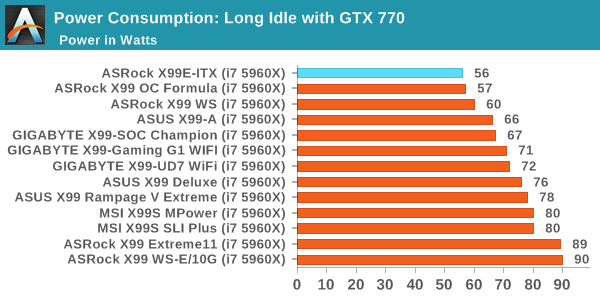

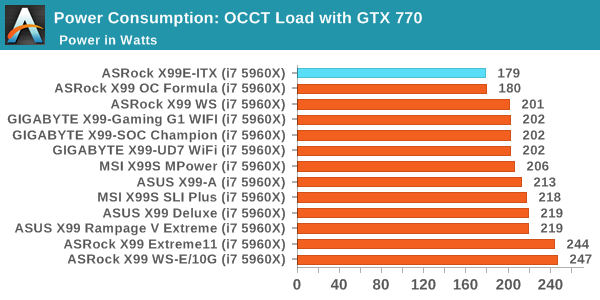
With the small form factor system, one would hope that the power consumption is low due to the lack of other components compared to the larger ATX and EATX motherboards. Thankfully, the X99E-ITX falls in line, almost matching the OC Formula but coming top in each metric. Part of this will be due to only having two modules of DRAM installed.
Windows 7 POST Time
Different motherboards have different POST sequences before an operating system is initialized. A lot of this is dependent on the board itself, and POST boot time is determined by the controllers on board (and the sequence of how those extras are organized). As part of our testing, we look at the POST Boot Time using a stopwatch. This is the time from pressing the ON button on the computer to when Windows 7 starts loading. (We discount Windows loading as it is highly variable given Windows specific features.)
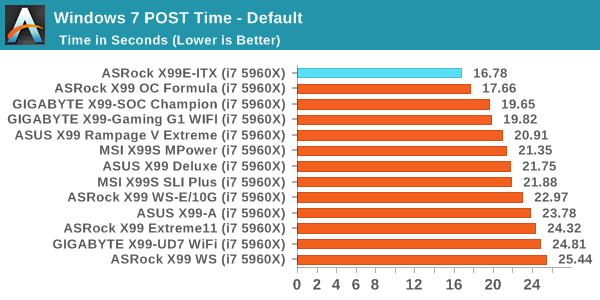
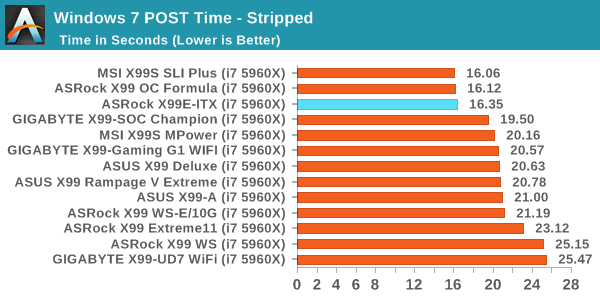
By virtue of having fewer components, one would also assume a quicker POST time. One of the big issues with POST time for X99 is DRAM testing/training at POST, which can take ten seconds and is required to ensure stability. By virtue of having fewer memory channels to be populated, the X99E-ITX gets nearer 15 seconds than the 20 second benchmark we normally have with X99 motherboards.
Rightmark Audio Analyzer 6.2.5
Rightmark:AA indicates how well the sound system is built and isolated from electrical interference (either internally or externally). For this test we connect the Line Out to the Line In using a short six inch 3.5mm to 3.5mm high-quality jack, turn the OS speaker volume to 100%, and run the Rightmark default test suite at 192 kHz, 24-bit. The OS is tuned to 192 kHz/24-bit input and output, and the Line-In volume is adjusted until we have the best RMAA value in the mini-pretest. We look specifically at the Dynamic Range of the audio codec used on board, as well as the Total Harmonic Distortion + Noise.
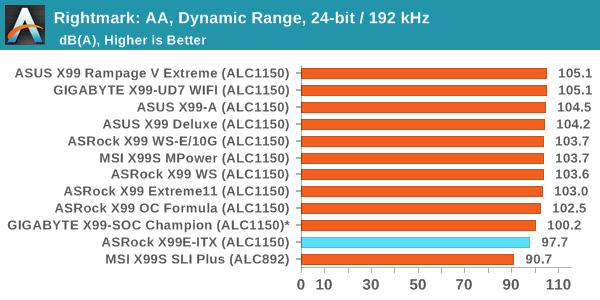
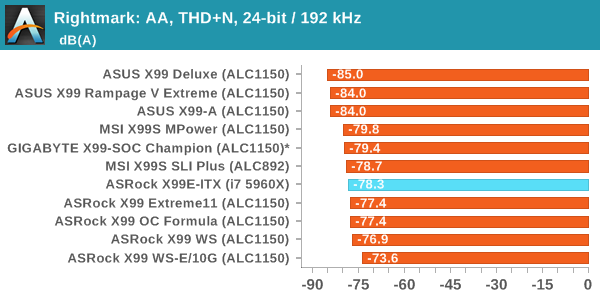
By having a smaller motherboard, ASRock is unable to implement the normal features around their improved ALC1150 audio solution. This technically should give a slightly noisier signal, and as a result the X99E-ITX/ac has a lower dynamic range than the other X99 motherboards with the ALC1150.
USB Backup
For this benchmark, we transfer a set size of files from the SSD to the USB drive using DiskBench, which monitors the time taken to transfer. The files transferred are a 1.52 GB set of 2867 files across 320 folders – 95% of these files are small typical website files, and the rest (90% of the size) are small 30 second HD videos. In an update to pre-Z87 testing, we also run MaxCPU to load up one of the threads during the test which improves general performance up to 15% by causing all the internal pathways to run at full speed.
Due to the introduction of USB 3.1, as of June 2015 we are adjusting our test to use a dual mSATA USB 3.1 Type-C device which should be capable of saturating both USB 3.0 and USB 3.1 connections. We still use the same data set as before, but now use the new device. Results are shown as seconds taken to complete the data transfer. As this way of testing is still new, we have only a few results so far.
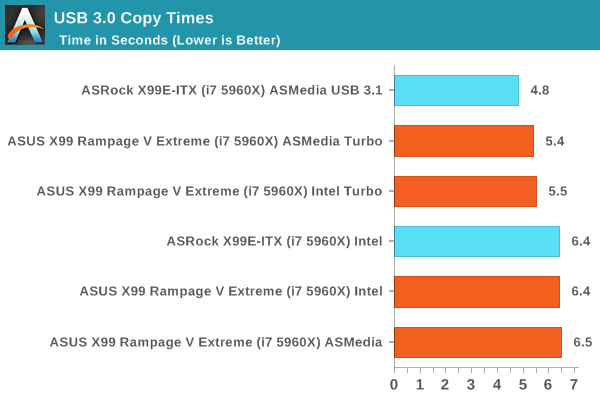
DPC Latency
Deferred Procedure Call latency is a way in which Windows handles interrupt servicing. In order to wait for a processor to acknowledge the request, the system will queue all interrupt requests by priority. Critical interrupts will be handled as soon as possible, whereas lesser priority requests such as audio will be further down the line. If the audio device requires data, it will have to wait until the request is processed before the buffer is filled.
If the device drivers of higher priority components in a system are poorly implemented, this can cause delays in request scheduling and process time. This can lead to an empty audio buffer and characteristic audible pauses, pops and clicks. The DPC latency checker measures how much time is taken processing DPCs from driver invocation. The lower the value will result in better audio transfer at smaller buffer sizes. Results are measured in microseconds.











56 Comments
View All Comments
mobutu - Wednesday, June 24, 2015 - link
In the Linus video that you linked in the article, they test is with 2*16 = 32GB RAM:https://youtu.be/MjDJNwAANwA?t=7m5s
Samus - Wednesday, June 24, 2015 - link
Ian, even if we are the only two customers asrock has for this board...I'm ok with that because I'm glad somebody actually took the time to properly engineer and manufacture the high end Intel platform in ITX. Just amazing what has been accomplished here.piasabird - Wednesday, June 24, 2015 - link
It kind of defeats the purpose to use a powerful CPU in a MINI-ITX system. X99 should be Quad Lane DDR4 Memory access. The more powerful the Processor the more it can benefit from lots of the fastest RAM. A MATX setup might make more sense. You are also forced to use a video card due to no onboard IGP for that socket.Samus - Thursday, June 25, 2015 - link
If you didn't want to use the PCIe lane for a video card, there is a BCM. You can boot and run the entire system without a videocard. The BCM can even do 1920x1080!You could easily add an 8" 8-port Areca SAS RAID card to that 16x slot, although I don't know why you'd want ITX (or this platform at all...) if your plan was to make a file server.
TomWomack - Friday, June 26, 2015 - link
Did you read the article? Its entire purpose was to quantify the cost of switching to dual-lane DDR4, and it quantified it as 'not very much under most circumstances'.glugglug - Wednesday, June 24, 2015 - link
They should have waited just a little longer, and included HD6200 graphics. A small server like this with QuickSync and no need for a video card would be something.Samus - Thursday, June 25, 2015 - link
You don't need a video card or onboard video. It has a management chip (BCM) that can output video via CAT5e. You can use a media converter or just use remote management.Gigaplex - Thursday, June 25, 2015 - link
Who would include the HD6200? That's part of the CPU, not the motherboard.fallaha56 - Wednesday, June 24, 2015 - link
stick a Fury Nano in this and let's see some action ;-)just4U - Wednesday, June 24, 2015 - link
I am interested in these smaller boards.. sure the Quad channel memory would be nice but whatever.. no biggie.. No crossfire/SLI isn't a issue for me either since I only ever use one Video Card (usually mid-high end)The only complaint.. I've yet to find a mini-itx case I want to build a system around. So I keep going the Matx route instead.